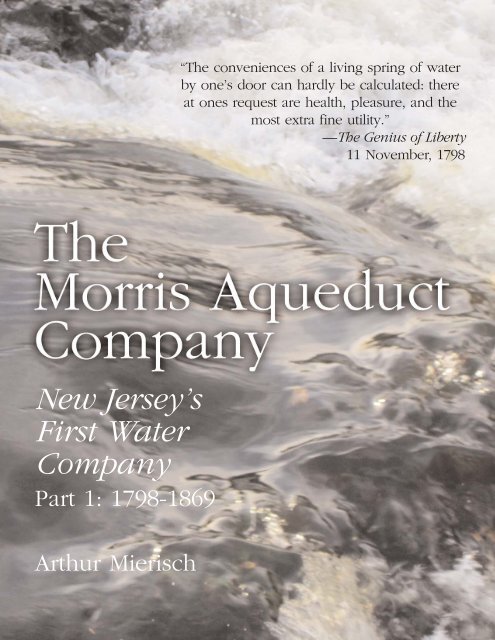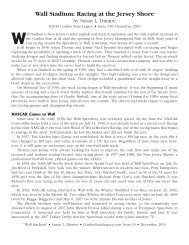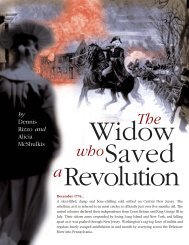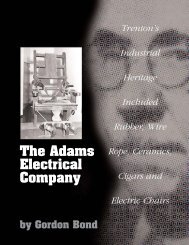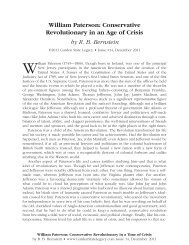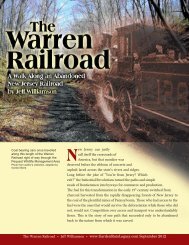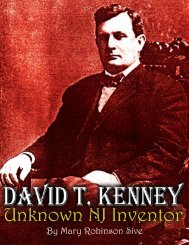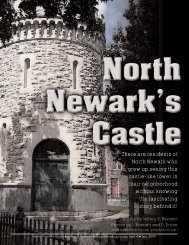The Morris Aqueduct Company - Garden State Legacy
The Morris Aqueduct Company - Garden State Legacy
The Morris Aqueduct Company - Garden State Legacy
You also want an ePaper? Increase the reach of your titles
YUMPU automatically turns print PDFs into web optimized ePapers that Google loves.
“<strong>The</strong> conveniences of a living spring of water<br />
by one’s door can hardly be calculated: there<br />
at ones request are health, pleasure, and the<br />
most extra fine utility.”<br />
—<strong>The</strong> Genius of Liberty<br />
11 November, 1798<br />
New Jersey's<br />
First Water<br />
<strong>Company</strong><br />
Part 1: 1798-1869<br />
Arthur Mierisch
Doctor Lewis Condict's 1797 home at the<br />
corner of South Street and Community Place<br />
is today's <strong>Morris</strong>town's Woman's Club. Dr.<br />
Condict was the first president of the <strong>Morris</strong><br />
County Medical Society, a shareholder and<br />
president of the <strong>Morris</strong> <strong>Aqueduct</strong> <strong>Company</strong>, a<br />
Congressman, and the first president of the<br />
<strong>Morris</strong> and Essex Railroad.<br />
Prolog<br />
<strong>The</strong> mid afternoon sun blinded Doctor Condict as he left his home that<br />
hot July day in 1798. “I feel old and tired. Why is it always so hot? Damn this<br />
place,” he thought as he locked his door and walked to the street. Every<br />
day he strode purposefully as if on a mission to help someone too ill or<br />
injured to come to his home. With his head bent towards the ground, he<br />
appeared to be deep in thought as if trying to resolve some imponderable<br />
question. <strong>The</strong> unbearable heat of the last two summers was affecting his<br />
health. He paused, put his hand in his coat’s side pocket and withdrew a<br />
soiled linen handkerchief. After wiping the perspiration that had trickled<br />
down his eyes and neck he used the handkerchief to fan his face. “It’s just<br />
as hot outside. I should stay home.” Suddenly a gust of wind erupted<br />
creating a funnel of gritty yellow dust. For seconds the Doctor disappeared<br />
into its spinning vortex before the funnel wandered in a strange pattern<br />
down the street. “Oh my eyes. When will this heat end? It’s so hot. We have<br />
to do something.”<br />
[Two blocks away] “Bow Wow! Wow! Wow! Wow!”<br />
“It’s that damn dog again. Why can’t Arnold keep Ben tied up?” thought<br />
the Doctor brushing the dust from his eyes. “That dog’s a menace,” he said<br />
in a low voice.<br />
“What’s that Doc? I can’t hear you. Talk louder,” said Jacob Mann<br />
standing underneath <strong>The</strong> Genius of Liberty sign hanging over his printing<br />
office. Jacob’s once white blouse and pants, now smeared with black ink<br />
was soaked with perspiration. Odd, somewhat grotesque patterns of black<br />
and gray covered his chest and arms and continued down his pant legs.<br />
“He looks terrible,” the Doctor thought shaking his head from side to<br />
side. “Jacob. This blasted heat! <strong>The</strong> wells are dry. Animals are dying. <strong>The</strong><br />
gardens are wilted. I don’t feel well. My mouth is dry Jacob. We need rain!”<br />
“I don’t know Doc. Can’t we dig another well and get . . . Listen! . . .<br />
It’s coming from O’Hara’s!”<br />
“I don’t hear . . . No wait! It’s Ben chasing Jefferson’s wagon,” the<br />
Doctor said.<br />
“That dog sure is crazy. He’s mean and ugly,” Jacob replied. “He likes<br />
biting horse’s legs. He’ll chase them for miles until they drop. <strong>The</strong> heats<br />
making him mad.”<br />
Dr. Condict’s eyes opened wide. “<strong>The</strong>y’re coming this way Jacob!<br />
Jefferson can’t stop his team!” the Doctor managed.<br />
<strong>The</strong> wagon raced down South Street. Joe and Pete, two of Jefferson’s<br />
strongest horses, pulled the wagon at a full gallop. Ben ran alongside<br />
barking and trying to bite their legs. Sacks of flower and vegetables<br />
bounced and slid off the wagon and disappeared into the dust raised by the<br />
horse’s hooves. “Kick that dog! Kick him!” yelled Jacob.<br />
<strong>The</strong> <strong>Morris</strong> <strong>Aqueduct</strong> <strong>Company</strong> • Arthur Mierisch • www.<strong>Garden</strong><strong>State</strong><strong>Legacy</strong>.com December 2012
April 17, 1799<br />
A melancholy event took place last<br />
Friday night. As Mr. James Gall was<br />
removing part of his household<br />
furniture to a farm he had lately<br />
taken, a vicious dog flew out and<br />
seized one of the horses by the heels<br />
and set the whole team off in a furious<br />
gallop. Mr. Gallaher attempted to<br />
throw himself off, but his left foot was<br />
caught in the stirrup. He was dragged<br />
a considerable distance before it broke.<br />
To finish the fatal catastrophe both<br />
wheels pulled over him - one across<br />
the breast and the other across the<br />
abdomen. To describe his mangled and<br />
tortured state is impossible,<br />
<strong>The</strong> Genius of Liberty<br />
August 22, 1779<br />
A gentlemen of respectability in-forms<br />
that Edward Griffith, a laborer went<br />
down a dry well 35 feet deep to dig for<br />
water. One side of the well collapsed<br />
burying Mr. Griffith.<br />
<strong>The</strong> Genius of Liberty<br />
Community Water Systems<br />
In 1652, Boston built a system that<br />
captured water from aquifers atop a<br />
hill. Gravity conducted the water<br />
through wooden pipes into a cistern<br />
below. Using pails and jugs, people<br />
carried water to their homes.<br />
In 1754, the Moravians in Bethlehem<br />
built the first successful community<br />
water supply. Steam engines pumped<br />
water through bored hemlock logs<br />
into a wooden reservoir above the<br />
town. <strong>The</strong> water was distributed<br />
downhill through wooden pipes.<br />
In 1771, private water companies in<br />
Philadelphia drew water from the<br />
Delaware using pumps. In 1799, the<br />
city built an aqueduct designed by<br />
Benjamin Latrobe, a noted hydraulics<br />
expert. Two large steam engines<br />
pumped water from the Schuylkill<br />
River through a 6 foot diameter<br />
tunnel.<br />
In 1796, Governor Samuel Adams of<br />
Massachusetts created an aqueduct<br />
corporation. Wood pipes carried water<br />
from Roxbury into Boston.<br />
“<strong>The</strong>y’re coming. I don’t know what to do!” the Doctor thought. He<br />
couldn’t move.<br />
“Doc get out of the way! You’ll be killed!” yelled Jacob.<br />
<strong>The</strong> Doctor’s face paled as the horses raced towards him. <strong>The</strong>y looked<br />
twenty feet tall. He tried to say “Help me!” but couldn’t.<br />
“Doc hurry!”<br />
Suddenly the Doctor was pulled aside. He lost his balance and<br />
collapsed. <strong>The</strong> wagon roared by with Ben in pursuit. “Whoa! Whoa!”<br />
shouted Jefferson.<br />
<strong>The</strong> Doctor looked up. “Doc I had to do it” Jacob said.<br />
“I’m better now Jacob . . . Help me. Thank God you’re here.”<br />
“<strong>The</strong> dust Doc. It’s bothering my eyes. We better go.”<br />
Five minutes later Doctor Condict and Jacob arrived at O’Hara’s.<br />
General Doughty, already seated, stood up pushing his chair hard against<br />
the wall. He yelled using his stentorian voice: “Doc! Jacob! What<br />
happened? Bartender! Send over mugs of your best wine and a broom to<br />
dust off my friends.”<br />
<strong>The</strong> Doctor, managing a smile said. “After I drink, I’ll tell you . . . we<br />
need water . . . something has to be done about that dog.”<br />
Doughty interrupted “Ok Doc. We will, but first listen to my plan.<br />
We’re going to get water!”<br />
<strong>Morris</strong>town—<strong>The</strong> Hub of Activity<br />
In 1776, <strong>Morris</strong>town’s two hundred and fifty residents were<br />
overwhelmed by the arrival of thousands of Continental Army soldiers.<br />
Situated between two mountains, the town provided winter protection for<br />
Washington’s troops. Local farms supplied vegetables, fowl and meat to<br />
the Army. Nearby, smelters and foundries clouded the air with smoke as<br />
they converted iron ore from Rockaway and Mine Hill into military<br />
armaments. <strong>The</strong> Powder Mill section of Denville produced the gun<br />
powder needed for the military’s rifles and cannons. Saw and grist mills,<br />
and tanneries harnessed the water power of the Whippany River<br />
producing flour and clothing. <strong>Morris</strong>town prospered throughout the<br />
Revolution and into the nineteenth century. By 1798, the town had over<br />
six hundred residents (not including an estimated three hundred seasonal<br />
migrant workers and servants living in the area). <strong>The</strong> town was the<br />
commercial center for goods moving to and from other parts of the<br />
country. Merchants with stores on the Green and on South and <strong>Morris</strong><br />
Streets sold the latest wines, home-goods, apparel and jewelry from New<br />
York and Philadelphia. People were heard talking about the new stage<br />
coach routes to Elizabethtown, Schooleys Mountain and even to<br />
<strong>The</strong> <strong>Morris</strong> <strong>Aqueduct</strong> <strong>Company</strong> • Arthur Mierisch • www.<strong>Garden</strong><strong>State</strong><strong>Legacy</strong>.com December 2012
Don't Drink the Water!<br />
Residents sensed that some illnesses<br />
came from foul tasting water while<br />
others traveled through the air.<br />
People collected human wastes in<br />
cesspits located behind houses.<br />
Contaminants from the pits seeped<br />
into wells that provided water for<br />
cooking and bathing. "Honey-dippers"<br />
(night-sailmen) emptied the pits and<br />
spread the manure in gardens further<br />
infecting the food supply. <strong>The</strong>y had<br />
not established the link between<br />
cholera and tainted drinking water.<br />
Communities desperately needed a<br />
pure and dependable supply.<br />
O'Hara's Tavern<br />
Taverns were the meeting places of the<br />
eighteenth century. People gathered there to<br />
eat, drink, and be entertained. <strong>The</strong>y played<br />
cards, board games, heard musical and<br />
poetry recitals, and danced into the night.<br />
Rooms on the second floor provided<br />
overnight accommodations. Horses were<br />
groomed and fed in the stable behind the<br />
tavern. Many patrons read newspapers over<br />
glasses of ale and wine while resolving local<br />
and worldly issues. <strong>The</strong>y made business<br />
decisions with friends and associates. People<br />
with various skills and backgrounds<br />
assembled to solve problems.<br />
Pennsylvania. In 1815, Stephen Vail expanded the Speedwell Iron Works<br />
where he manufactured agricultural and industrial machinery. He was<br />
noted for the first durable iron wheel for railroad locomotives. In 1838, the<br />
<strong>Morris</strong> and Essex Railroad was extended to <strong>Morris</strong>town from Madison.<br />
<strong>The</strong> railroad curved by the front of the Immaculate Conception Church<br />
and terminated at the end of Railroad Avenue (now Maple Avenue) at the<br />
old DeHart Street depot. <strong>The</strong> railroad improved transportation for people<br />
and goods moving across the state. By 1869, <strong>Morris</strong>town’s population had<br />
increased to over 6,000 residents.<br />
In <strong>Morris</strong>town, people grew vegetables, raised chickens and pigs in<br />
their back yards. Outside of town, larger farms grew cotton, grains, and<br />
vegetables, and raised sheep, cattle and horses. Several doctors served the<br />
community’s sick and injured. Every Thursday, the Genius of Liberty, the<br />
town’s paper, distributed the often months old local, national and world<br />
news to homes and taverns. <strong>The</strong> town, unable to raise sufficient money<br />
from taxes and lotteries, depended on freeholders, merchants and wealthy<br />
residents to finance and administer public works projects. Freeholders and<br />
townspeople widened roads, built bridges across small streams, and<br />
formed private fire brigades and anti horse stealing societies. <strong>State</strong><br />
chartered companies erected government buildings, and bridges and roads<br />
needed for intra-state commerce. Entrepreneurs seeking profits opened<br />
banks and turned trails into toll roads. <strong>Morris</strong>town’s population grew in<br />
response to increased economic activity throughout the county.<br />
<strong>The</strong> spring and summer of 1797 and 1798, were hot and dry. <strong>The</strong>re was<br />
little rain causing the town’s water table to drop. Those with the deepest<br />
wells shared water with their thirsty neighbors while others dug deeper,<br />
down thirty feet or more. Many were disappointed when they found dry<br />
layers of clay and rocks. <strong>The</strong> dirt streets became the pathways for dust<br />
storms created by the slightest breeze. <strong>Morris</strong>town was in trouble. <strong>The</strong><br />
town needed a dependable water supply—the most important commodity<br />
necessary for sustaining life and commerce. Residents believed that the<br />
aquifers on Mount Washington (now Mount Kemble) offered a solution.<br />
<strong>The</strong>se underground streams seeped water that was cool and pure and<br />
more palatable than the town’s well water. Residents imagined having the<br />
luxury of running water and a tree shaded town watered by nearby<br />
springs.<br />
Doctor Condict’s fictionalized walk to O’Hara’s Tavern never<br />
happened. However, the excessive heat, dry wells, wilting crops, and<br />
crazed animals encouraged him and others to meet and discuss ways to<br />
relieve the water shortage. <strong>The</strong>y were men of financial means who<br />
possessed the planning and administrative skills needed to initiate public<br />
projects. O’Hara’s tavern, centrally located on the south side of the Green,<br />
<strong>The</strong> <strong>Morris</strong> <strong>Aqueduct</strong> <strong>Company</strong> • Arthur Mierisch • www.<strong>Garden</strong><strong>State</strong><strong>Legacy</strong>.com December 2012
1799 Proprietors of the <strong>Morris</strong><br />
<strong>Aqueduct</strong> <strong>Company</strong><br />
(as listed in the Charter)<br />
<strong>Aqueduct</strong> shareholders were officers in<br />
the Army, doctors, lawyers, judges,<br />
businessmen and politicians. Many<br />
sponsored and organized fire<br />
departments, schools and quasi police<br />
departments. Businessmen and bankers<br />
invested in the <strong>Aqueduct</strong> seeking profits<br />
while enjoying running water at their<br />
doorsteps. Streets in <strong>Morris</strong>town have<br />
been named in their honor.<br />
General John Doughty<br />
Adjutant General during the<br />
Revolution, farmer, first<br />
President of <strong>Morris</strong> <strong>Aqueduct</strong> Co.<br />
Major Daniel Phoenix<br />
Officer during Revolution,<br />
in 1815 director of the <strong>Morris</strong><br />
Fire Association, and a <strong>Morris</strong><br />
Academy subscriber<br />
Captain Israel Canfield<br />
Rolling mill owner, incorporator of<br />
<strong>Morris</strong>town to Phillipsburg turnpike,<br />
County Judge, Sheriff, a <strong>Morris</strong> <strong>Morris</strong><br />
Academy subscriber<br />
Captain David Ford<br />
Served in Continental Army, forge<br />
owner, organizer of <strong>Morris</strong> Academy,<br />
invested in turnpikes<br />
William Campfield<br />
Colonel in Army, assemblyman, sheriff,<br />
organizer of the <strong>Morris</strong> Academy, fire<br />
and agricultural and manufacturing<br />
societies<br />
Gabriel H. Ford<br />
Landowner, organizer of <strong>Morris</strong><br />
Academy, invested in turnpikes<br />
Joseph Lewis<br />
Wealthy businessman, organizer of the<br />
<strong>Morris</strong> Academy and Fire Association,<br />
County Judge<br />
Alexander Carmichael<br />
Assemblyman, Justice of the Peace,<br />
organizer of fire dept. and <strong>Morris</strong><br />
Academy<br />
Rodolophus Kent - Attorney<br />
Doctor Lewis Condict<br />
Physician, Sheriff, County Judge,<br />
President of <strong>Morris</strong> <strong>Aqueduct</strong> Co. 1834<br />
Dr. Abraham Canfield - Physician<br />
Matthias Crane - Church Elder<br />
John Halsey<br />
Stage Coach Owner/Operator<br />
Caleb Russell<br />
Forge Owner, Attended College of NJ,<br />
Judge, <strong>Morris</strong> Academy organizer<br />
was where they met. <strong>The</strong>re they planned to build New Jersey’s first water<br />
company—the <strong>Morris</strong> <strong>Aqueduct</strong> <strong>Company</strong>. <strong>The</strong> founders, men educated<br />
in the liberal arts tradition were confident that they could raise the capital<br />
needed to build and operate an aqueduct. Aware of their technical<br />
limitations they enlisted the aid of an experienced hydraulics expert from<br />
Boston. <strong>The</strong> founders of the <strong>Company</strong> were willing to invest their time<br />
and money to improve their town’s health and to derive a financial benefit<br />
from a much needed service.<br />
Part I of the <strong>Morris</strong> <strong>Aqueduct</strong> <strong>Company</strong> tells the history of the<br />
Companies first seventy years of operation from 1799 to 1869. This was<br />
the era when the <strong>Company</strong> struggled to remain in business using available<br />
materials—pipes made from wood and cement!<br />
Part II to be published at a future date, continues the Companies<br />
history from 1869 to 1923 when it was taken over by the <strong>Morris</strong>town<br />
Water <strong>Company</strong>. During these fifty four years the business became a<br />
modern water company by installing cast iron pipes, steam pumps and<br />
covered reservoirs. <strong>The</strong> business maintained a dependable water service<br />
and for many years paid dividends in cash and stock.<br />
Information about the <strong>Company</strong>’s operation has been recorded in the<br />
minutes of shareholder meetings held from 1799 through 1823. Thirty five<br />
years later in 1868 the minutes resume. During these missing years, the<br />
<strong>Company</strong> suffered bankruptcy and was taken over by James Wood and<br />
John Voorhees, entrepreneurs. Deeds from the <strong>Morris</strong> County Clerk’s<br />
Office and newspaper articles have added details about the <strong>Company</strong>’s<br />
operation. Budgets, plans and correspondence have not been recorded in<br />
their Book of Minutes. This article is factual and salted with much<br />
imagination to fill in the gaps missing in records. Doctor Condict’s<br />
fictionalized walk is used to emphasize how the town struggled during the<br />
early years of the <strong>Aqueduct</strong> <strong>Company</strong>. Conversations with John Doughty,<br />
Jacob Mann, Rodolophus Kent, James Wood, and John Voorhees, are<br />
fictional.<br />
<strong>The</strong> Charter<br />
In 1798, there were two types of businesses in New Jersey—small and<br />
large. Small businesses were unregulated partnerships between two or<br />
more people. A person was called a proprietor if they owned or shared<br />
ownership in a tavern, a newspaper, tannery, clothing store, forge, etc. As<br />
an owner they were personally responsible for all debts incurred by the<br />
business.<br />
Large, risky undertakings that needed a great amount of money from<br />
many people had to be chartered (incorporated) by the <strong>State</strong>. <strong>The</strong> <strong>Morris</strong><br />
<strong>Aqueduct</strong> <strong>Company</strong> was one of these ventures. Initially this business<br />
<strong>The</strong> <strong>Morris</strong> <strong>Aqueduct</strong> <strong>Company</strong> • Arthur Mierisch • www.<strong>Garden</strong><strong>State</strong><strong>Legacy</strong>.com December 2012
COMMUNICATION<br />
<strong>The</strong> people of the <strong>Morris</strong>-Green, will<br />
doubtlessly have their expectations<br />
more than answered, provided the<br />
<strong>Aqueduct</strong> succeeds well. Next to a<br />
spring of cool water, the Poets,<br />
Orators, Historians, and even<br />
philosophers have celebrated Shades.<br />
This town, especially the Green, and<br />
streets leading to it, seem only to want<br />
the ornaments to render it pleasant<br />
and delightful, almost beyond<br />
description. A row of Shades, equi<br />
distantly placed, at each side of the<br />
way, about one third of the extent of<br />
fourth-street to the green-thence<br />
running round the green, and<br />
enclosing the church, would greatly<br />
beautify this already celebrated village<br />
- would render those walks<br />
exceedingly charming - would prevent<br />
that parched appearance the green<br />
makes in the heat of summer - would<br />
conduce to health - in a word, would<br />
render this one of the most<br />
enchanting scenes in nature.<br />
<strong>The</strong> Genius of Liberty<br />
11 November, 1799<br />
Stock Transfer<br />
Know all men by these presents that I<br />
Lucretia Russell widow and devisee of<br />
Caleb dec. [deceased] & in<br />
consideration of one hundred dollars,<br />
the receipt whereof is hereby<br />
acknowledged, do hereby grant,<br />
bargain, sell, release, convey and<br />
confirm unto Charles Russell two full<br />
shares of the <strong>Morris</strong> <strong>Aqueduct</strong> to be<br />
had and beholden unto the said<br />
Charles Russell his heirs, executors,<br />
administrators and assigns, to the only<br />
proper use benefit and behoove of the<br />
said Chas Russell his heirs, Executors,<br />
administrators and assigns forever---<br />
Witness my hand & seal May the<br />
twentieth day ado Eighteen hundred &<br />
thirteen.<br />
Lucretia Russell<br />
needed thousands of dollars to construct a system before service could<br />
begin. It was a huge undertaking requiring four miles of trenches in which<br />
logs shaped into pipes were joined together to conduct water from Mount<br />
Washington into <strong>Morris</strong>town. A person became a shareholder and a<br />
proprietor when they purchased stock in the <strong>Company</strong>. <strong>State</strong> law required<br />
businesses to hold annual meetings and to have their records audited by<br />
qualified accountants. <strong>The</strong> company was led by a president and was<br />
assisted by five directors who coordinated construction and maintenance<br />
activities. At meetings the proprietors created bylaws necessary for the<br />
businesses operation. A secretary/clerk kept the minutes of meetings,<br />
recorded stock transfers, and collected subscription fees from subscribers.<br />
Unlike today’s corporations where loans and company assets are used to<br />
pay debts, the shareholders were assessed for these liabilities.<br />
Approval of the <strong>Morris</strong> <strong>Aqueduct</strong> Companies Charter in 1799 destined<br />
the business to become one of the oldest privately owned corporations in<br />
the country. <strong>The</strong> Charter, prepared with the aid of Rodolophus Kent, was<br />
modeled after Boston’s and Philadelphia’s. It contained provisions<br />
necessary to construct and operate an aqueduct. <strong>The</strong> Charter stated that<br />
“a number of inhabitants [the original proprietors] of <strong>Morris</strong>town have<br />
associated together for the purpose of supplying themselves and their<br />
neighbors with water.” <strong>The</strong> right of shareholders included: “<strong>The</strong><br />
Proprietors of the <strong>Morris</strong> <strong>Aqueduct</strong>, their successors and assigns, shall<br />
have perpetual succession” to the business. <strong>The</strong> Charter stipulated that the<br />
proprietors could lawfully buy and sell property, and could “lay and<br />
extend the said aqueduct to such places and through any lands that may<br />
be necessary to continue the same where now lay.” To always obtain<br />
water, the Charter legalized the trespassing upon non <strong>Aqueduct</strong> property:<br />
“it may be lawful for said proprietors, their artists and laborers, with carts,<br />
wagons, and other beasts of burden, and all necessary tools and<br />
implements, to enter upon the lands contiguous or near the aqueduct and<br />
to carry away any stone, sand or earth that may impede the aqueduct or<br />
to repair or improve the aqueduct.”<br />
<strong>The</strong> Charter emphatically stated how lawsuits brought by underage<br />
children and employees are settled.<br />
<strong>The</strong> proprietors are to make amends to owners of the property, in a<br />
reasonable amount, for any damages. If the property owner is under<br />
age, or non compos mentis, or out of the state, then twelve good and<br />
lawful men be summoned, sworn, affirmed and empanelled by virtue<br />
of a warrant from any judge of the Inferior Court of Common Pleas.<br />
<strong>The</strong> panel will recommend a settlement amount to the Court. <strong>The</strong><br />
court will make the final judgment. <strong>The</strong> court will also settle suits<br />
brought against the proprietors by their artists or laborers.<br />
<strong>The</strong> <strong>Morris</strong> <strong>Aqueduct</strong> <strong>Company</strong> • Arthur Mierisch • www.<strong>Garden</strong><strong>State</strong><strong>Legacy</strong>.com December 2012
<strong>The</strong> Charter told how meetings were to be conducted and specified the<br />
rights of shareholders:<br />
<strong>The</strong> <strong>Company</strong> is to notify proprietors ten days in advance for the<br />
time and place of the next business meeting to be held in <strong>Morris</strong>town.<br />
<strong>The</strong> President and others deemed necessary shall conduct and<br />
manage the meetings. <strong>The</strong> President and board shall serve for one<br />
year. New officers will be elected at the first business meeting of the<br />
year. A proprietor will have one vote for every share he holds. At<br />
meetings the proprietors, for the well being and ordering of affairs,<br />
can make laws, rules and orders for the ordering of affairs. <strong>The</strong>se<br />
shall not be inconsistent with the laws of the state.<br />
In 1799, the United <strong>State</strong>s economy was still recovering from the<br />
depression of 1783. Local governments were unable to finance and<br />
conduct public works projects. <strong>The</strong>se activities were taken over by<br />
Companies, also known as Societies and financed by wealthy and<br />
influential businessmen. Proprietors of the <strong>Morris</strong> <strong>Aqueduct</strong> <strong>Company</strong><br />
afforded the $50 ($800 in 2010 dollars) per share price. A shareholder had<br />
one vote per share. Most bought one share, some two shares. John<br />
Doughty owned three shares giving him a stronger say in <strong>Company</strong><br />
operations. Each proprietor was authorized to do business in the<br />
<strong>Company</strong>’s name and could sell shares without prior approval. During<br />
meetings, the clerk entered stock transactions into the Book of Transfers.<br />
Construction<br />
During the spring of 1799, the Proprietors hired Pelatiah Ashley, a<br />
noted hydraulics expert (the term engineer was first used in the 1820’s) to<br />
build the <strong>Morris</strong> <strong>Aqueduct</strong>. <strong>The</strong> Genius of Liberty praised his<br />
accomplishments:<br />
. . . and the work executed by, and under the immediate direction of<br />
Mr. Pelatiah Ashley of West-Springfield Massachusetts, whole<br />
industry, integrity, sobriety, and carefulness merit the hearty<br />
recommendations of the citizens of this town, and whole practical<br />
and experimental knowledge, in conveying water by aqueduct, will<br />
be found, on experiment, to be more useful to his employers than the<br />
theoretical knowledge of hydraulics.<br />
An 1800 newspaper report about water usage in New Jersey said that<br />
“the <strong>Aqueduct</strong> <strong>Company</strong> was charted by the legislature to supply water to<br />
Newark.” No mention of this is found in the <strong>Company</strong>’s minutes.<br />
<strong>The</strong> <strong>Morris</strong> <strong>Aqueduct</strong> <strong>Company</strong> • Arthur Mierisch • www.<strong>Garden</strong><strong>State</strong><strong>Legacy</strong>.com December 2012
1799 <strong>Morris</strong>town<br />
1. Ford Mansion<br />
2. Schuyler-Hamilton House<br />
3. Dickerson House<br />
4. Memorial Hospital<br />
5. Norris Tavern<br />
6. Fulling, Grist and Saw Mills, Furnace, Forges<br />
7. Moses Estry House<br />
8. Presbyterian Church<br />
9. Baptist Church<br />
10. Court House and Jail<br />
11. U.S. Hotel<br />
12. Arnold Tavern<br />
13. Timothy Mills House<br />
14. Sheriff's Office<br />
15. Shoemaker, Weaver<br />
16. O'Hara's Tavern<br />
17. DeHart House<br />
18. Dr. Lewis Condict House<br />
19. <strong>The</strong> Genius Of Liberty<br />
20. <strong>Morris</strong> Academy<br />
21. Samuel Tuthill House<br />
<strong>The</strong> <strong>Morris</strong> <strong>Aqueduct</strong> pipes ran from<br />
Western Avenue to South Street, the<br />
Green and <strong>Morris</strong> Street<br />
However, Pelatiah Ashley may have been involved in two New Jersey<br />
projects, one of these Newark’s.<br />
A newspaper revealed local sentiment about aqueducts:<br />
It was the wonder of the age when the streets were opened for the<br />
laying of the first main. Many an old-timer viewed with alarm the new<br />
fangled notion of bringing water from the distant springs to the back<br />
door. <strong>The</strong> alarmist predicted all sort of evil consequences. <strong>The</strong> town<br />
might be flooded some day when the pipes had rotted away, and other<br />
calamities were sure to follow.<br />
<strong>The</strong> proprietors trusted Pelatiah Ashley. Knowing that he disliked the<br />
costly and unreliable pipes made from iron, copper, ceramic and leather,<br />
they accepted his recommendation to use sturdier and inexpensive logs.<br />
Ashley took control and organized teams to auger 2 and 4 inch diameter<br />
holes down the center of the each log creating a pipe. One end was tapered<br />
and the other end enlarged so that the pipe sections fit together. When set<br />
in the ground, sections were sealed with tar, sap or cement and held in place<br />
with metal straps. <strong>The</strong> 4 inch pipes known as mains connected to 2 inch<br />
pipes that ran to subscriber’s establishments.<br />
Once the <strong>Aqueduct</strong> was built and Ashley had left <strong>Morris</strong>town, the<br />
Proprietors believed that they possessed the logical disciplines necessary to<br />
operate the <strong>Company</strong>. After all they were educated men trained in solving<br />
problems needing logical deduction. For example, they knew that water<br />
<strong>The</strong> <strong>Morris</strong> <strong>Aqueduct</strong> <strong>Company</strong> • Arthur Mierisch • www.<strong>Garden</strong><strong>State</strong><strong>Legacy</strong>.com December 2012
AQUEDUCT PIPES<br />
On Saturday. <strong>The</strong> 30th instant, at 4<br />
o'clock P.M. near Barrell's Bakery, on<br />
the Green, a quantity of Logs, for<br />
<strong>Aqueduct</strong> Pipes, will be ordered for<br />
sale. <strong>The</strong> timber of many is sound and<br />
good, and will answer a valuable<br />
purpose for cellar drains, and other<br />
convenience for water. Those which<br />
are unfit for pipes will make good<br />
fencing stakes.<br />
L. CONDICT<br />
B. FREEMAN<br />
Directors of the<br />
<strong>Morris</strong> <strong>Aqueduct</strong> <strong>Company</strong><br />
March 26, 1811<br />
inside a pipe would flow downhill if one end was raised above the other.<br />
<strong>The</strong> taller the pipe, the greater the pressure at the bottom of the column.<br />
<strong>The</strong>y reasoned that water flowing downhill in a 4 inch pipe would provide<br />
enough pressure to equally the distribute water about town. By 1805, the<br />
Proprietors through experience learned that friction inside a pipe retarded<br />
the flow of water. Could they solve this problem?<br />
During May of 1799, the <strong>Aqueduct</strong> <strong>Company</strong> advertised for workmen<br />
to dig a four mile trench and for contractors to deliver tree sections to<br />
Pelatiah Ashley at Jockey Hollow for auguring. Workmen supplied their<br />
own tools, food, and clothing. Overnight shelter was not provided.<br />
Wanted immediately, a number of hands to dig a ditch three feet<br />
deep and eighteen inches broad for which service, 6 shillings [$36 in<br />
2010 dollars] per day, and the price of half a pint of spirits upon every<br />
four [64 feet] rods, will be given every Saturday. <strong>The</strong> persons who<br />
engage are to furnish themselves with tools and provision; or if any<br />
person wishes to contract for digging, by the rod [16 feet], he may<br />
have an opportunity by applying to either of the subscribers in<br />
<strong>Morris</strong>town on Saturday the 29 th<br />
at five o’clock in the afternoon,<br />
when a number of lots, containing eight rods in a lot, will be sold to<br />
the lowest bidder.—Also will be sold to the lowest bidder, the right<br />
and privilege of contracting lumber suitable for said <strong>Aqueduct</strong>, for—<br />
ty allotments each, to contain 25 [400 feet] rods in length, and the<br />
lumber to be good chestnut, or other timber to be approved of by<br />
subscribers; to be delivered to Mr. Ashley’s works for boring, in<br />
Jockey Hollow; not more than eight feet three inches long to be sawed<br />
and cut square at each end; to be no less than eight inches in diameter<br />
exclusive of the bark.<br />
An ad for workmen to dig a trench appeared a week later:<br />
Will be sold in lots of 20 rods [320 feet] each, to the person who will<br />
undertake to do the cheapest, the digging of a trench 18 inches broad,<br />
and 3 and a half feet deep . . .<br />
“It’s too hot. Why all that noise?” complained many residents during<br />
the summer of 1799. Others tolerated the sounds of oxen dragging logs<br />
and pipes sections up and down the mountain, and along South and<br />
<strong>Morris</strong> Streets. <strong>The</strong>y welcomed the congestion of wagons and horses<br />
going in all directions around the Green in anticipation of the fresh water<br />
that soon would flow into town.<br />
Often a merchant would drive his wagon down DeHart Street to avoid<br />
<strong>The</strong> <strong>Morris</strong> <strong>Aqueduct</strong> <strong>Company</strong> • Arthur Mierisch • www.<strong>Garden</strong><strong>State</strong><strong>Legacy</strong>.com December 2012
In 1799, a single share in the <strong>Morris</strong><br />
<strong>Aqueduct</strong> <strong>Company</strong> sold for $50.00<br />
(about $800.00 in 2010 dollars). A pricey<br />
investment considering that a farm<br />
laborer earned $80 a year compared to<br />
doctors who earned $500 a year. It was<br />
an investment for the wealthy that<br />
offered the convenience of running<br />
water.<br />
the slow moving oxen plodding along Bank Street. O’Hara’s and Arnold’s<br />
taverns served ale, wine and rabbit stew to exhausted workmen every<br />
weekday and Saturday night. Thank God for Sunday many thought as they<br />
rose at dawn and prepared for Church. It was a day of rest for all—even<br />
the animals.<br />
A 4 mile long trench 2 feet wide by 3 feet deep was dug along the<br />
Jockey Hollow Road (now Western Avenue) southwest of <strong>Morris</strong>town. It<br />
began at an aquifer 100 feet above the town and sloped downhill to a<br />
junction point at Ann and Court Streets. From there it spread like the roots<br />
of a giant tree around the Green and down South and <strong>Morris</strong> Streets.<br />
Depressions in the terrain were filled with dirt, rocks and chunks of clay<br />
so that the pipe always sloped downhill. At Court Street stopcocks and<br />
petcocks controlled the flow of water in each of the branches. Over 1,700<br />
sections of pipe were placed in the trench, joined and covered over with<br />
dirt leaving a long continuous mound of dirt above ground—as if a mole<br />
had tunneled through the town giving away the <strong>Aqueduct</strong>s path. Teams<br />
of 80 laborers, 10 supervisors, 8 oxen and 10 horses toiled six days a week<br />
for three months to complete the project. It was a notable achievement for<br />
<strong>Morris</strong>town in 1799.<br />
To passersby, the Spring House located a mile from town along<br />
Western Avenue looked odd surrounded by seventy foot tall oak and<br />
chestnut trees. <strong>The</strong> building, a one story 10 foot by 10 foot log structure<br />
was without windows and a chimney. Light entered only when its heavy<br />
rough hewn wooden door creaked open. A latch, used in place of a lock,<br />
kept the door closed. <strong>The</strong> House protected the aquifer inside from invasion<br />
by animals, leaves and wooded debris. This was the <strong>Aqueduct</strong> <strong>Company</strong>’s<br />
source of water. In the middle of the dirt floor, the first section of the<br />
wooden pipe protruded 2 feet below ground level into an almost circular<br />
4 foot diameter hole. Out of the ground and into the hole seeped the water<br />
destined for <strong>Morris</strong>town. Stopcocks along the way controlled the flow of<br />
water on its downhill course.<br />
Tuesday, the 13 th of October 1799, was a memorable day for the <strong>Morris</strong><br />
<strong>Aqueduct</strong> <strong>Company</strong>. Monday, the day before was cloudy, but on this day<br />
the sky was clear, the air crisp and an occasional puff of a cotton like cloud<br />
drifted eastward across the sky. <strong>The</strong> noontime sun bathed the crowd<br />
gathered at the Court Street junction. “Look at that sky. It’s definitely a<br />
good omen” said Jacob Mann talking with Doctor Condict and William<br />
DeHart standing near the pipe. About forty five merchants and residents<br />
gathered nearby awaiting the arrival of John Doughty, the town’s most<br />
noted citizen.<br />
Exactly at noon, John Doughty, dressed in his colonel’s uniform<br />
galloped up the hill and dismounted before a cheering crowd of sixty<br />
<strong>The</strong> <strong>Morris</strong> <strong>Aqueduct</strong> <strong>Company</strong> • Arthur Mierisch • www.<strong>Garden</strong><strong>State</strong><strong>Legacy</strong>.com December 2012
people. He stepped up two feet onto a three foot wide stump placed near<br />
the <strong>Aqueduct</strong>s pipe. This was the Court Street junction where the pipe<br />
from the Mount Kemble aquifer joined the pipe that connected to the town<br />
branches. He raised his right hand high above his head and proclaimed:<br />
“Proprietors, my friends, and residents. May I have your attention! Today<br />
is a great day for <strong>Morris</strong>town.” He continued with emphasis: “For today<br />
. . . COOL . . . FRESH WATER . . . will for the first time flow into our town!<br />
Everyone will enjoy the 8 gallons per minute that will shortly arrive at our<br />
doorsteps.” For the next ten minutes he told of the efforts of the<br />
Proprietors and the many laborers who toiled building the <strong>Aqueduct</strong>. He<br />
even lauded Pelatiah Ashley for contributing his expertise and without his<br />
guidance the <strong>Aqueduct</strong> would not have been possible. He thanked<br />
everyone for their patience and assured them that they will enjoy the<br />
benefits of having a dependable water supply. “It’s time” he said glancing<br />
at portly Daniel Phoenix who had been loading his rifle. Doughty<br />
proclaimed: “Daniel fire your rifle!” Phoenix pointed it towards the sky<br />
and pulled the trigger. A small puff of smoke erupted near Daniel’s face<br />
and a low hiss was heard as the primer burned. Suddenly a boom echoed<br />
down the valley and a ten foot blast of smoke erupted from the barrel. This<br />
was the signal for the workmen at the Spring House to open the stopcock.<br />
Doctor Condict in unison opened the petcock near Doughty’s feet.<br />
Everyone cheered. <strong>The</strong>ir hussars could be heard blocks away.<br />
Fifteen minutes later not a drop of water arrived. Murmers with<br />
unpleasant overtones were heard from the crowd. Someone shouted<br />
“<strong>The</strong>re’s no water!”<br />
“Give it time!” Doughty injected. “I can hear it.” Of course he couldn’t<br />
hear it, but he had to say something as the crowd’s frustration grew.<br />
“Will water ever flow?” a man in a sarcastic tone yelled. “I told you it<br />
wouldn’t work!”<br />
Doughty, stepped back onto the stump, raised his arms towards the<br />
sky and proclaimed: “<strong>The</strong> Spring House is a mile away. It takes time to get<br />
here.”<br />
Twenty minutes passed. Water began to seep from the pipe. Five<br />
minutes later a two inch spout appeared. A satisfied smile crossed<br />
Doughty’s perspiring face. “It’s here! It’s here!” He said as if relieved of a<br />
burden. “Close the petcock Doctor!”<br />
As the pipe filled water flowed into town. <strong>The</strong> crowd’s mood changed.<br />
<strong>The</strong>y became jovial as they turned and walked towards the Green. <strong>The</strong>ir<br />
hussars were heard as far as Arnold’s tavern. <strong>The</strong> Proprietors almost ran<br />
down the hill. <strong>The</strong>y rushed to their establishments anticipating with every<br />
step the taste of the cool clear water awaiting them.<br />
<strong>Morris</strong>town was amazed. <strong>The</strong> community was the third in the country<br />
<strong>The</strong> <strong>Morris</strong> <strong>Aqueduct</strong> <strong>Company</strong> • Arthur Mierisch • www.<strong>Garden</strong><strong>State</strong><strong>Legacy</strong>.com December 2012
First and Last Notice<br />
All persons indebted to the <strong>Morris</strong><br />
<strong>Aqueduct</strong> <strong>Company</strong>, are hereby<br />
notified to pay their arrears to Charles<br />
Russell, Treasurer, of the <strong>Company</strong>, on<br />
Saturday, the 25th, between the hours<br />
of 9 o'clock and 5 in the afternoon, at<br />
the office of C. Russell. All persons<br />
neglecting to do so, are required to<br />
enter their appearances to actions to<br />
be instituted against them, before E.<br />
Condict, Esq.<br />
Charles Russell, Treas. Feb 11, 1809<br />
<strong>The</strong> Genius of Liberty<br />
Minutes of 25th of May 1868<br />
Be Resolved that a loan of $5,000 from<br />
the <strong>Morris</strong>town Savings Bank be taken<br />
to be used for the Bridge Street pipe<br />
and to pay off a loan of $2,000 and<br />
interest to the firm of the late John<br />
Voorhees.<br />
to have running water. All of the Proprietors expectations came true. No<br />
longer did they have to drink from contaminated wells and they had water<br />
to buffer times of drought. <strong>The</strong>y looked forward to the pleasure of<br />
drinking the cool pure water from the mountain stream. Within hours,<br />
residents presented Doughty with their $50.00 shareholder fee and others<br />
waited in line asking to subscribe to the service. “My friends please be<br />
patient? It’s already November and snows are coming. It’s too late for<br />
digging. After next year’s thaw we’ll reach your door” replied Doughty.<br />
Two days later, on Thursday November 18, 1799, <strong>The</strong> Genius of Liberty<br />
announced the successful completion of the <strong>Aqueduct</strong>. Into town flowed<br />
water of the highest and unequaled quality.<br />
An aqueduct of 4 miles in length, including the various branches, had<br />
been laid down and completed in this town, since the 20 th of June last<br />
which affords to the citizens, at their doors a constant flowing spring<br />
of pure and fine water as may be found in the United <strong>State</strong>s; it is<br />
equal to the purest rain water for washing . . . the pipe is running<br />
through the woods for nearly a mile, is not only secure from the<br />
influence of the sun, but in all probability from the severity of the<br />
frost likewise.<br />
During 1800, the branches were extended throughout town and<br />
connections made to more customers. In 1805, a small reservoir was built<br />
(now a municipal parking lot) at Ann and Court Streets. <strong>The</strong> reservoir held<br />
60 hogsheads (a measure of capacity equating to 3,780 gallons or 14,280<br />
liters) of water.<br />
Income and Expenses<br />
In 1799, the <strong>Aqueduct</strong> <strong>Company</strong> sold 45 shares of stock at $50 a share<br />
to 30 proprietors. Much of the $2,250 raised was paid to Pelatiah Ashley<br />
for his services, and to contractors for logs. A share entitled the holder to<br />
a one vote in the company’s operations. Owning more shares gave the<br />
holder a stronger say in the business. Gabriel Ford invested $200 for 4<br />
shares and William Campfield spent $150 for 3 shares. Each proprietor<br />
acted as an agent and sold shares to interested investors. Sales of stock<br />
were entered into the Book-of-Transfers during meetings. Being a<br />
stockholder (shareholder) meant that the investor shared the businesses<br />
profits and was responsible for the businesses debts. When the company<br />
owed money, each proprietor was assessed a reconciling amount.<br />
Customers who were not shareholders were known as subscribers and<br />
paid $7.00 ($105 in 2010 dollars) per annum for a 2” pipe running from a<br />
4” main to their establishment. For the next twenty years the <strong>Company</strong><br />
<strong>The</strong> <strong>Morris</strong> <strong>Aqueduct</strong> <strong>Company</strong> • Arthur Mierisch • www.<strong>Garden</strong><strong>State</strong><strong>Legacy</strong>.com December 2012
A typical 1832 Bank Note. Banks<br />
made loans using their own unsecured<br />
notes. <strong>The</strong> <strong>State</strong> Bank of <strong>Morris</strong><br />
established in 1812, conducted business<br />
at the corner of Park Place and Bank<br />
Street. Within a few years, the bank<br />
failed and was succeeded by the <strong>Morris</strong><br />
County Bank in 1836. <strong>The</strong> Iron Bank of<br />
Rockaway moved to <strong>Morris</strong>town in<br />
1858, a year after the <strong>Morris</strong> County<br />
Bank failed. A competitor, the <strong>Morris</strong><br />
Savings Bank opened its door in the<br />
1860's. Many <strong>Aqueduct</strong> Proprietors<br />
were principles of these banks.<br />
accepted the currencies from other countries. English pounds and French<br />
Franks were preferred over weak American dollars.<br />
Annual meetings were held in January and emergency meetings were<br />
called throughout the year as needed. Benjamin Freeman’s home hosted<br />
many sessions. Attendance was mandatory and absentees were fined. In<br />
1799, absent shareholders were assessed 1 or 2 English shillings, ($6 or $12<br />
in 2010 dollars). In 1807, William Johnes was fined 12 1/2 cents for being<br />
tardy and an additional 12 1/2 cents for leaving early! 12 1/2 was less than<br />
$3.00 in 2010 dollars. In 1810, a committee was appointed to determine<br />
what excuses should be allowed for non attendance.<br />
Once completed, a staff of workers maintained the system. One man,<br />
a supervisor and five assistants directed the efforts of thirty laborers who<br />
for nine months a year were kept busy digging trenches and replacing<br />
pipes. How to find and replace a leaking pipe was a difficult task. Robert<br />
Conklin, Supervisor would tell his crew: “<strong>The</strong>y’re not getting water.<br />
Check the ground for wet spots. <strong>The</strong> leak will be there.”<br />
<strong>The</strong> Spring House, often raided by vandals (local boys suspected),<br />
required monthly repairs to the door and clearing matted leaves and twigs<br />
from the pipe. Workmen had to remove all obstructions. If debris lodged<br />
deeper within the pipe, the pipe was disconnected and a long pole used to<br />
push out the obstruction. <strong>The</strong> pipe would then be reconnected and service<br />
resumed. As branches were extended small cisterns were positioned in the<br />
streets to collect unused water.<br />
In 1807, escalating maintenance costs raised the subscription fee to<br />
$10.00 per annum. A fine of $2.00 was levied on anyone taking too much<br />
water. Violators were determined by inspecting the petcock at the<br />
subscriber’s location. If opened beyond the allowable setting, too much<br />
water would pass and the subscriber fined. In 1810, any subscriber using<br />
water to construct a brick building was charged $10 a year for the service.<br />
Expenses from 1800 through 1869 always exceeded income causing<br />
the business to operate at a loss. <strong>The</strong> <strong>Company</strong> borrowed from banks and<br />
wealthy residents lent money to the business. In 1810, a loan of $400 was<br />
repaid to J. Langer.<br />
Each shareholder was required to pay a portion of the losses in<br />
relation to the number of shares they owned. Assessments began in 1805<br />
at $2.00 a share and increased due to rising costs to $6.00 a share by 1817.<br />
Many shareholders stopped attending meetings and refused to pay their<br />
assessments and attendance fines. In 1807, much to the joy of defaulted<br />
shareholders, a bylaw forfeited all shares held by a proprietor who<br />
neglected to pay their installments. In 1810, the <strong>Company</strong> attempted<br />
unsuccessfully to prosecute defaulting proprietors.<br />
Occasionally the <strong>Company</strong> raised money through the sale of land and<br />
<strong>The</strong> <strong>Morris</strong> <strong>Aqueduct</strong> <strong>Company</strong> • Arthur Mierisch • www.<strong>Garden</strong><strong>State</strong><strong>Legacy</strong>.com December 2012
equipment, and cancelling leases. However, debts continued to climb.<br />
Fire! Fire!<br />
To fight a fire in 1800, a hole was<br />
augured in an <strong>Aqueduct</strong> pipe. Water<br />
trickled from the pipe into a bucket or<br />
pail. When full it was carried to and<br />
thrown on the fire. When not in use,<br />
the hole was closed with an oak or<br />
teak plug.<br />
Shareholder Meetings<br />
Friday, November 16 th 1799, was a day that not yet President of the<br />
<strong>Aqueduct</strong> <strong>Company</strong>, John Doughty would ever forget. Only three days<br />
after service commenced, he encountered his first problem. Taking action,<br />
he sent a messenger to each proprietor ordering them to assemble at<br />
Benjamin Freeman’s home by mid afternoon. Doctor Condict, the last to<br />
arrive was rushed into the parlor led by William DeHart. <strong>The</strong>y heard<br />
Doughty saying: “Gentlemen please forgive me for calling you here on<br />
short notice. As you already know, we have a problem with the <strong>Aqueduct</strong>.<br />
I can’t walk past O’Hara’s without someone, even Proprietors, telling me<br />
that their water’s not flowing, or its foul tasting, or they’re not getting<br />
enough. We have to do something.” Doughty paused to take a drink of<br />
wine. As he put down his glass he commanded: “Gentlemen! I’m calling<br />
this meeting to order. David [Ford] you have good penmanship, please<br />
take minutes. Let’s get started!”<br />
David Ford came prepared. He sat at Freeman’s desk and opened his<br />
satchel. Reaching in, he withdrew several sheets of paper, and a thick<br />
white hard bound book. Book-of-Transfers was neatly lettered on the<br />
cover. Carefully he withdrew a bottle of ink and six goose-feather pens.<br />
With a small knife, he sharpened these to a point. After uncorking the<br />
bottle, he dipped a pen into the ink and began writing. It sounded like<br />
scratching: <strong>The</strong> Minutes of the <strong>Morris</strong> <strong>Aqueduct</strong> <strong>Company</strong>, November . . .<br />
Next, Doughty asked everyone to register their stock sales with David.<br />
A half hour later Doughty appointed an emergency committee of five<br />
proprietors, led by Doctor Condict “to inquire why the water was not<br />
drawn through the pipe and to remedy the situation.” <strong>The</strong> Committee,<br />
known as the committee-of-five, within minutes suggested “venting the<br />
pipe to air and tomorrow we’ll assemble a crew and open all of the<br />
branches.” Discussion followed about the amount of water distributed.<br />
<strong>The</strong> proprietors wondered what went wrong. <strong>The</strong>y believed Pelatiah<br />
Ashley when he said that the system would deliver 8 gallons per minute<br />
to each subscriber. Or did he mean 8 gallons a minute to the junction at<br />
Court Street? After much debate, they reduced the quantity to 1 gallon per<br />
minute. That’s 60 gallons per hour, still an impossible amount for a 4 inch<br />
pipe.<br />
Later in November 1799, the charter was approved. David Ford placed<br />
a notice in <strong>The</strong> Genius of Liberty notifying the Proprietors of their first<br />
annual meeting to be held on January 2 nd 1800, at Benjamin Freeman’s<br />
home. On that day at 2:00 PM John Doughty pounded his mug three times<br />
against Freeman’s desk and called the meeting to order. “Gentlemen! Let<br />
<strong>The</strong> <strong>Morris</strong> <strong>Aqueduct</strong> <strong>Company</strong> • Arthur Mierisch • www.<strong>Garden</strong><strong>State</strong><strong>Legacy</strong>.com December 2012
<strong>The</strong> 1790s Newsham Fire Engine<br />
directed water into fires. It was a<br />
wooden pump with a flexible leather<br />
hose that connected to the water<br />
supply.<br />
<strong>The</strong> <strong>Morris</strong>town Fire Association<br />
formed in 1797, was replaced by the<br />
<strong>Morris</strong>town Fire <strong>Company</strong> in 1815. In<br />
1836, two competing fire companies<br />
were formed. An act passed in 1837,<br />
consolidated the companys into the<br />
<strong>Morris</strong>town Fire Association. It raised<br />
money for equipment and expenses<br />
through taxation.<br />
In 1825 arson was punishable by 25<br />
years in prison!<br />
us begin. We have to elect officers and have much work to do” he said.<br />
Doctor Condict seated near the fireplace stood and nominated John<br />
Doughty for President. He was seconded and unanimously elected. After<br />
twenty minutes of discussion the group resolved that Doughty’s duties<br />
included conducting shareholder meetings, maintaining relationships<br />
with town officials, recommending the extending of mains to new<br />
subscribers, and negotiating leases, property sales and purchases. Doughty<br />
was to appoint committees to recommend ways to improve service.<br />
Gabriel H. Ford became the first Vice President. Three Directors were<br />
chosen: Daniel Phoenix, John Halsey and William Campfield. Matthias<br />
Crane was appointed Treasurer, Timothy Tuttle became the first<br />
Accountant and Henry King the Clerk. A committee of the shareholders,<br />
some with accounting experience, were selected to yearly audit the books.<br />
Doughty asked several members to prepare bylaws for next year’s annual<br />
meeting. At 5:15 PM the meeting ended. <strong>The</strong> Proprietors returned home<br />
confident that all problems were resolved.<br />
Subscriber complaints continued that year. Everyone was upset over<br />
the appearance, aroma and taste of the water. Doughty called emergency<br />
meetings in February, April, and September to resolve this problem.<br />
During April’s meeting he ordered “a hole opened up at the end of each<br />
main once a week for the purpose of cleaning the pipe until the filth is<br />
discharged.” After a summer of flushing, the water’s taste improved. In<br />
September, Directors were appointed and charged with assuring “that a<br />
quantity of water is not missing the pipe in the Spring House.” Blockages<br />
at the House caused an insufficient amount of water to enter the pipe.<br />
From 1779 to 1860, the <strong>Company</strong> met at Proprietor homes for business<br />
meeting and at a table in one of the <strong>Morris</strong>town taverns where<br />
subscription fees were collected. Benjamin Freeman, George O’Hara,<br />
Stephen Halsey, and Mrs. Halsey, the wife of deceased John Halsey hosted<br />
many sessions. <strong>The</strong>y were paid $1.00 for refreshments that always<br />
included wine and ale. In 1860, the <strong>Company</strong> was given a desk in the law<br />
office of John Pitney, an <strong>Aqueduct</strong> shareholder. Here subscriber fees were<br />
accepted, workmen and creditors paid, and real estate transactions took<br />
place.<br />
Meetings lasted for hours. It took the Secretary time to record the<br />
minutes created by the wordy proprietors. Imagine the time needed to dip<br />
the quill into the ink and then write six to ten words before the pen needed<br />
another dipping. And how many times did the Secretary have to stop and<br />
ask the Proprietors to repeat a long entry? <strong>The</strong> Secretary’s script was<br />
always legible. No cross-outs were found. Often the Secretary made<br />
notations during meetings and expanded them into minutes the next day.<br />
People wrote legibly during the eighteenth and early nineteenth<br />
<strong>The</strong> <strong>Morris</strong> <strong>Aqueduct</strong> <strong>Company</strong> • Arthur Mierisch • www.<strong>Garden</strong><strong>State</strong><strong>Legacy</strong>.com December 2012
Events that Influenced<br />
<strong>Morris</strong> County's Economy<br />
Agricultural, leather, and textile<br />
production, and fabricated iron<br />
equipment<br />
1793 - Eli Whitney's invention of cotton<br />
harvesting equipment stimulated cotton<br />
growing. By 1830, the south harvested 2<br />
million acres up from 300,000 acres in<br />
1800. <strong>Morris</strong> County benefited from the<br />
increased demand for linens and leather<br />
goods.<br />
1807 - Robert Fulton established<br />
steamboat service along the Hudson<br />
River, coastal rivers and waterways, and<br />
inland along the Ohio and Mississippi<br />
Rivers. <strong>Morris</strong> Country produced iron<br />
products used on boats.<br />
1812 - <strong>Morris</strong> County built armaments<br />
for the War of 1812.<br />
1813 - Speedwell Iron Works went into<br />
production.<br />
1820 - <strong>The</strong> <strong>Morris</strong> Canal used steam<br />
powered equipment manufactured at<br />
the Speedwell Works.<br />
1831 - Immigrant farmers begin to<br />
flood western territories increasing the<br />
demand for housing, clothing and farm<br />
equipment. Speedwell Iron Works made<br />
boilers for Ohio and Mississippi River<br />
steam boats and farm equipment.<br />
1836 - <strong>The</strong> <strong>Morris</strong> and Essex Railroad<br />
transported people and goods between<br />
Jersey City and <strong>Morris</strong>town. <strong>The</strong> rails<br />
were cast from ore mined locally.<br />
1837 - A panic griped the country<br />
caused by inflated prices, land<br />
speculation, banks notes issued without<br />
backing, and businesses borrowing in<br />
anticipation of increased profits. Sixty<br />
percent of businesses closed. People<br />
worked for food. <strong>The</strong> state and national<br />
governments were unable to provide<br />
relief.<br />
1842 - <strong>The</strong> Mexican War brought<br />
Texas into the Union and the California<br />
gold rush began. <strong>Morris</strong> County<br />
increased the production of iron and<br />
agricultural products. <strong>The</strong> country<br />
returned to work.<br />
1861 - <strong>The</strong> American Civil War began.<br />
<strong>Morris</strong> County produced gunpowder<br />
and armaments.<br />
century taking time to write neatly in straight lines across unlined paper.<br />
Each page was an artistic accomplishment. An oddity of the style was the<br />
depiction of the letter s making reading documents and newspapers<br />
difficult. Words that began with a small s or capital S were written as an s<br />
or S. However, a lower case s inside of a word appeared as an elongated f.<br />
<strong>The</strong> word “passage” became “paffage.” Happily in 1820, the convention<br />
changed—a written f meant f. <strong>The</strong> secretary kept the original copy of the<br />
minutes making them available to interested Proprietors.<br />
In 1799, thirty shareholders owned forty five shares. <strong>The</strong> minutes<br />
recorded that an average of eighteen shareholders attended each session<br />
and represented an average of thirty shares. <strong>The</strong>y considered this<br />
representation sufficient to pass resolutions. However, if attendance was<br />
light, the meetings were cancelled and rescheduled. From 1801 through<br />
1817, a proprietor absent without a valid excuse was fined in shillings.<br />
After 1817, fines were levied in dollars, now the accepted currency of the<br />
United <strong>State</strong>s. <strong>The</strong> Secretary called the meetings to order. No mention<br />
about the approval of the minutes of the previous meeting was made. <strong>The</strong><br />
President began by speaking about the physical and economic condition<br />
of the <strong>Aqueduct</strong>. Next new and old business was discussed and resolutions<br />
made.<br />
John Doughty was perplexed. Subscribers along South and Market<br />
Streets complained that they were not receiving water while others<br />
insisted that their neighbors were giving water away. Doughty assembled<br />
a committee to resolve the situation. After months of investigation, the<br />
Proprietors decided to fine violators $2 a day for each day that water was<br />
given away to non subscribers. Proprietors were told to keep a watchful<br />
eye on cisterns and report anyone stealing water. <strong>The</strong> service was<br />
discontinued for anyone found “wantonly” wasting water. Subscribers still<br />
not receiving their share of water were indemnified 2 cents per day.<br />
In 1803, President Doughty, at the request of the <strong>Morris</strong>town Council<br />
on Safety appointed a committee to devise a plan to extinguish fires. <strong>The</strong><br />
committee recommended connecting a pump directly to an <strong>Aqueduct</strong><br />
pipe, or to a cistern located within twenty feet of the fire. However, if the<br />
fire was further away, the pump was placed inside a large wooden trough<br />
10 feet long x 5 feet wide x 1 1/2 feet deep. <strong>The</strong> trough was kept full by a<br />
bucket brigade. <strong>The</strong> pump was positioned within 10 feet of the fire. If<br />
operated vigorously, it sprayed water a maximum distance of 15 feet.<br />
However, if the fire was too hot, the pump could not get near the building<br />
and was ineffective. Unfortunately, water trickled out of the <strong>Aqueduct</strong>s<br />
pipe and buckets filled too slowly. Brigades relied on well water—if<br />
available.<br />
Security of the Spring House troubled the Proprietors. In 1803, vandals<br />
<strong>The</strong> <strong>Morris</strong> <strong>Aqueduct</strong> <strong>Company</strong> • Arthur Mierisch • www.<strong>Garden</strong><strong>State</strong><strong>Legacy</strong>.com December 2012
From Minutes 1860<br />
Value of <strong>Company</strong><br />
Charter and water rights,<br />
and pipes laid before 1847 . . . .$5,000<br />
Construction since 1847 . . . . . . . .6,000<br />
Brick Grist Mill . . . . . . . . . . . . . . . .6,500<br />
Reservoir Lot . . . . . . . . . . . . . . . . . . .500<br />
Value of current property . . . . . .18,000<br />
Deduct original stock,<br />
45 shares at $50 each . . . . . . . . .2,500<br />
1860 Value of <strong>Company</strong> . . . . . .$15,750<br />
Resolved: That a Committee be<br />
appointed to procure an Engine of<br />
sufficient capacity to raise water from a<br />
spring on the land owned by Mr.<br />
Voorhees on the Jockey Hollow Road to<br />
the distributing Reservoir.<br />
Resolved: That it is expedient to<br />
immediately enlarge the Reservoir on<br />
the hill in Court Street<br />
broke in and blocked water from entering the pipe. <strong>The</strong> Proprietors<br />
resolved to put a lock on the door and offered a $5.00 reward “for persons<br />
committing an offense on the Spring House.”<br />
In 1804, the Proprietors resolved to increase the amount of water<br />
flowing into town. Dr. Condict led a committee to “consider erecting a<br />
reservoir on the high ground adjacent to the Green at the two pipes (the<br />
junction point where the pipe from the mountain connected to the pipe<br />
going into town).” <strong>The</strong>y advocated construction of a reservoir at the<br />
corner of Court and Ann Streets. It would store water at night for use the<br />
next day. A year later, the project was completed. <strong>The</strong> reservoir measured<br />
10 feet long on the side facing Ann Street by 20 feet wide by 3 feet deep.<br />
It held 60 hogsheads (3,780 gallons or 484 cubic feet) of water. It worked—<br />
more water was available.<br />
<strong>The</strong> Proprietors experimented with different types of pipes. In 1805,<br />
David Mills connected 60 feet of leather pipe to his residence. It cost $15<br />
(about $500 in 2010 dollars) to verify that a leather pipe would leak when<br />
softened by flowing water—he replaced it with a wooden pipe. By 1810,<br />
the Proprietors scorched wooden pipes hoping to smooth the inner<br />
surface. <strong>The</strong> results were minimal. However, they succeeded in adding to<br />
the awful taste of the water.<br />
In 1808, the Directors, fearful that they might go bankrupt, resolved<br />
that the <strong>Aqueduct</strong> “be leased for a term not less than fifteen nor more than<br />
thirty years to any person or persons who will undertake to supply the<br />
Proprietors with water at the rate of five dollars per subscriber per<br />
annum.” William Campfield dissatisfied with the service accepted the<br />
offer. He located several small aquifers, and directed the water into one of<br />
<strong>Morris</strong>town’s mains. Two years later he surrendered the lease. He had<br />
underestimated expenses and was unable to supply water at the five dollar<br />
rate.<br />
In 1820, the Proprietors determined to increase the water flow,<br />
replaced fifty feet of rotted sections with thin flexible lead pipes. <strong>The</strong><br />
experiment failed—the pipes leaked when crushed by the weight of the<br />
soil and leaked when freezing water expanded opening the joints.<br />
1800 to 1869<br />
<strong>Morris</strong>town welcomed the <strong>Aqueduct</strong>. After 1800, mains were<br />
extended to connect new subscribers and cisterns installed to store excess<br />
water. <strong>The</strong> problems facing the Proprietors increased as branches were<br />
extended. In 1815, the <strong>Company</strong> temporarily halted the sale of stock until<br />
the water quality improved. Although shareholder meetings did not<br />
record what improvements were made, months later new stock sales were<br />
resumed and subscriptions increased. Perhaps subscribers preferred water<br />
<strong>The</strong> <strong>Morris</strong> <strong>Aqueduct</strong> <strong>Company</strong> • Arthur Mierisch • www.<strong>Garden</strong><strong>State</strong><strong>Legacy</strong>.com December 2012
from the pipe compared to the not so tasty well water. <strong>The</strong>y tolerated<br />
service interruptions and water quality for the convenience of running<br />
water.<br />
By 1834, John Doughty, Doctor Condict, and many of the original<br />
<strong>Aqueduct</strong> Proprietors had passed away. <strong>The</strong>ir estates sold shares to pay<br />
the deceased debts. Any balance was divided among relatives and friends<br />
included in the will. <strong>The</strong> new owners had little interest in operating a<br />
business that was bankrupt. James Wood, a wealthy businessman, seeing<br />
an opportunity for profits, began purchasing <strong>Aqueduct</strong> stock for 10 cents<br />
a share. For the next fifteen years he repaired and replaced rotted pipes<br />
with new ones fashioned from sturdier chestnut logs. Wood located a<br />
source of water at the end of Western Avenue near Jockey Hollow <strong>State</strong><br />
Park. Nearby he built a small eighteen foot square reservoir and connected<br />
it to the pipe at the Spring House. Water then flowed continuously into<br />
<strong>Morris</strong>town. Subscribers still complained about the water pressure and the<br />
taste.<br />
<strong>The</strong> War of 1812, threatened the stability of the United <strong>State</strong>s. <strong>Morris</strong><br />
County’s economy thrived as orders for iron armaments and equipment,<br />
and agricultural products soared. <strong>Morris</strong>town’s population grew and by<br />
1849, there were over 3,500 residents. Demand for <strong>Aqueduct</strong> water<br />
increased as the population increased. James Wood, tiring of the business<br />
and unable to profit from his original investment sold a controlling<br />
interest to his friend John F. Voorhees, for ten cents a share. Voorhees<br />
replaced all of the wooden pipes with cast cement pipes at his own<br />
expense, and rebuilt and enlarged the Court Street reservoir using stone,<br />
bricks and mortar. Even with these changes, subscribers continued to<br />
dislike the water’s taste. Further improvements in service were delayed<br />
until after the Civil War.<br />
<strong>The</strong> minutes of 1860 valued the <strong>Company</strong> at $15,750. This was to “be<br />
divided into 315 shares of $50 each and distributed among stockholders<br />
and that 360 shares be issued at a ratio of 7 to 1, valuing the <strong>Company</strong> at<br />
$18,000.” This equates to $550,000 in 2010 dollars. Voorhees, the<br />
controlling investor owned 320 shares and five other investors owned 40<br />
shares.<br />
In 1799, <strong>Morris</strong>town stood alongside Boston, Philadelphia and New<br />
York City as one of the wealthiest communities in the United <strong>State</strong>s. <strong>The</strong>se<br />
cities were the first to install running water systems in support of their<br />
economies. Although the <strong>Aqueduct</strong> <strong>Company</strong>’s water was not of the<br />
highest quality, it was an acceptable convenience when compared with<br />
the often unavailable well water.<br />
<strong>The</strong> <strong>Morris</strong> <strong>Aqueduct</strong> <strong>Company</strong> failed as a business. It was always in<br />
debt much to the dismay of its investors. It could not provide the quality<br />
<strong>The</strong> <strong>Morris</strong> <strong>Aqueduct</strong> <strong>Company</strong> • Arthur Mierisch • www.<strong>Garden</strong><strong>State</strong><strong>Legacy</strong>.com December 2012
and quantity of water demanded by subscribers. However, as a convenient<br />
and somewhat dependable source of water, the <strong>Morris</strong> <strong>Aqueduct</strong><br />
<strong>Company</strong> was a success. It provided <strong>Morris</strong>town with the primary<br />
element needed for life—water.<br />
Prolog—1869<br />
<strong>The</strong> 2:00 p.m. sun blinded John C. Pitney as he stepped out of the<br />
<strong>Morris</strong> Academy onto South Street. He always admired the building for its<br />
distinctive architecture. Someone told him that they put Greek, Italian,<br />
Roman and Turkish styles into a sack, shook it up, and out came the<br />
Academy. It was supposed to be cool inside being protected from the sun<br />
by its thick brick and mortar walls. “It’s just as hot inside,” he murmured<br />
as he walked towards the Green. He thought that the building would give<br />
him relief from the oppressive heat that had scorched <strong>Morris</strong>town for the<br />
past two months. At age forty five his thick brown hair began graying<br />
around temple temples. He was of average height, standing five feet eight<br />
inches tall and weighing one hundred and seventy five pounds. Today he<br />
looked shorter. Three months ago he strutted, shoulders back as if on an<br />
important mission to be somewhere in town. Now, he shuffled down the<br />
street with his head bent towards the ground. He appeared to be deep in<br />
thought or was he exhausted? As he passed Dr. Condict’s old house, he<br />
reached into his jacket’s side pocket and removed a soiled crumpled<br />
handkerchief. Wiping the perspiration from his brow he thought: Where<br />
can I go? Suddenly a gust of wind erupted creating a spinning cloud of<br />
yellow grit that engulfed him as it twisted and wandered haphazardly<br />
down the street. Oh my eyes. When will this heat end? It’s so hot. No rain.<br />
<strong>The</strong> pipe is clogged. I have to do something.<br />
[Two blocks away] “Bow Wow! Wow! Wow! Wow!”<br />
It’s that damn dog again. He’s always around the Green. Why can’t<br />
Fairchild tie him up? thought Pitney, as he brushed the dust from his face<br />
and hair. “That dogs a menace” he said in a low voice.<br />
“What’s that John? I can’t hear you. Talk louder!” said John Voorhees<br />
walking slowly towards him.<br />
Voorhees jacket was soaked with perspiration. “You look terrible,”<br />
Pitney said shaking his head from side to side. “<strong>The</strong>re’s no water again.<br />
Even the cisterns are dry. I can fix the pipe.”<br />
“I don’t know John. Can’t we put in a steam pump?” Asked Voorhees.<br />
“Wait! Do you hear barking? It’s coming from the Green!”<br />
“It’s that dog, he’s gone crazy again. Something’s coming this way, it<br />
looks like he’s chasing a wagon,” said Pitney.<br />
To be continued . . . . . .<br />
<strong>The</strong> <strong>Morris</strong> <strong>Aqueduct</strong> <strong>Company</strong> • Arthur Mierisch • www.<strong>Garden</strong><strong>State</strong><strong>Legacy</strong>.com December 2012
Bibliography<br />
Armstrong, Ellis L., Editor, History of Public Works in the United <strong>State</strong>s, 1776–1976,<br />
American Public Works Association, Chicago, Illinois, 1976<br />
Beers, F. W., Atlas of <strong>Morris</strong> County, 1868, <strong>Morris</strong> Township Library, <strong>Morris</strong>town, NJ<br />
Bell, Augustus W., Old Fire Association and the Present Fire Department of <strong>Morris</strong>town<br />
1797–1926, <strong>Morris</strong>town and <strong>Morris</strong> Township Library, <strong>Morris</strong>town, N.J, 1976<br />
Book of Deeds, <strong>Morris</strong> County Hall of Records, <strong>Morris</strong>town, NJ<br />
Burns, William E., Science and Technology in Colonial America, Greenwood Press,<br />
Westport, Conn., 2005<br />
Busch, John Laurence, Steam Coffin, Hodos Historia, United <strong>State</strong>s of America, 2010<br />
Craig, Robert W., Historic Data Report, <strong>Morris</strong>town <strong>Aqueduct</strong> <strong>Company</strong> Reservoir, Heritage<br />
Studies, Princeton, N.J., 1978<br />
French, Bruce H., Banking and Insurance in New Jersey: A History, D. Van Nostrand Co.,<br />
Inc., Princeton, NJ, 1965<br />
Garratt, Colin, the World Encyclopedia of Locomotives, Hermes House, New York, NY,<br />
1997<br />
<strong>The</strong> Genius of Liberty, Issues: 1798–1810, <strong>Morris</strong> Township Library, <strong>Morris</strong>town, NJ<br />
Jerseyman Index, Issues: 1870–1922, <strong>Morris</strong> Township Library, <strong>Morris</strong>town, NJ, 1978<br />
Lurie, Maxine N., Mappen Marc Editors, Encyclopedia of New Jersey, Rutgers University<br />
Press, New Brunswick, New Jersey, 2004<br />
Mann, Jacob, Editor, Genius of Liberty, Issues: 1798–1811, <strong>Morris</strong> Township Library,<br />
<strong>Morris</strong>town, NJ<br />
Melosi, Martin U., the Sanitary City, the University of Pittsburgh Press, Pittsburgh, Pa.,<br />
2000<br />
Mierisch, Arthur, the Genius of Liberty, Part I: <strong>The</strong> World, the Frontier, Marriage, Health &<br />
Other 1799 Events,<br />
<strong>Garden</strong><strong>State</strong><strong>Legacy</strong>.com Issue 7, March 2009<br />
Mierisch, Arthur, <strong>Morris</strong> Township’s 1770 Industrial Complex, <strong>Garden</strong><strong>State</strong><strong>Legacy</strong>.com<br />
Issue 7, September 2009<br />
Microfilm: <strong>Morris</strong> <strong>Aqueduct</strong> Archives, Records and Clippings, 1799–1917 [Contents: Books<br />
of transfers, 1799–1855 and Corporate Charter, 1799; Minutes, 1799–1816; Account<br />
book, 1828–1830 and Minutes, 1816–1822; Minutes 1860–1917 and Scrapbook],<br />
<strong>Morris</strong>town and <strong>Morris</strong> Township Library, <strong>Morris</strong>town, N.J.<br />
Mierisch, Arthur, the Genius of Liberty, Part II: Tavern Talk, <strong>Garden</strong><strong>State</strong><strong>Legacy</strong>.com Issue<br />
7, March 2010<br />
<strong>Morris</strong>town Historical Society, 139 History of <strong>Morris</strong> Count New Jersey 1882, W. W.<br />
Munsell & Co. New York, NY, 2000<br />
Palladium of Liberty, Issues: 1808–1834, <strong>Morris</strong> Township Library, <strong>Morris</strong>town, NJ<br />
Smith, Dennis, Dennis Smith’s History of Firefighting in America, <strong>The</strong> Deal Press, New<br />
York, NY, 1978<br />
South Mountain County Municipal Water Authority, Notes on <strong>Morris</strong> <strong>Aqueduct</strong><br />
<strong>Company</strong>, Cedar Knolls, N. J. 2010<br />
Worsley, Lucy, If Walls Could Talk, Walker Publishing <strong>Company</strong> Inc., New York, NY,<br />
2011<br />
Thursday, December 13, 2012 Page 15<br />
<strong>The</strong> <strong>Morris</strong> <strong>Aqueduct</strong> <strong>Company</strong> • Arthur Mierisch • www.<strong>Garden</strong><strong>State</strong><strong>Legacy</strong>.com December 2012


